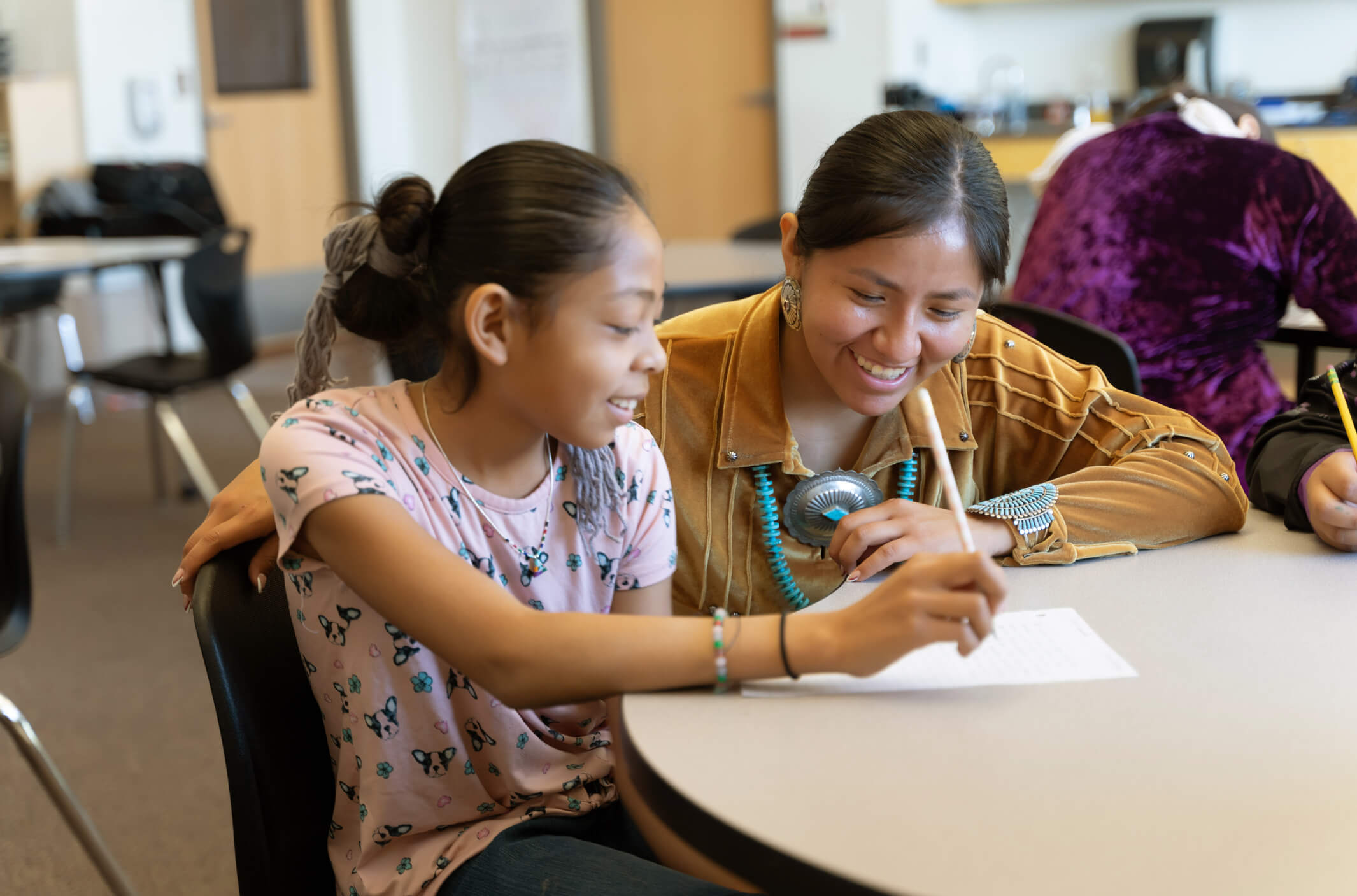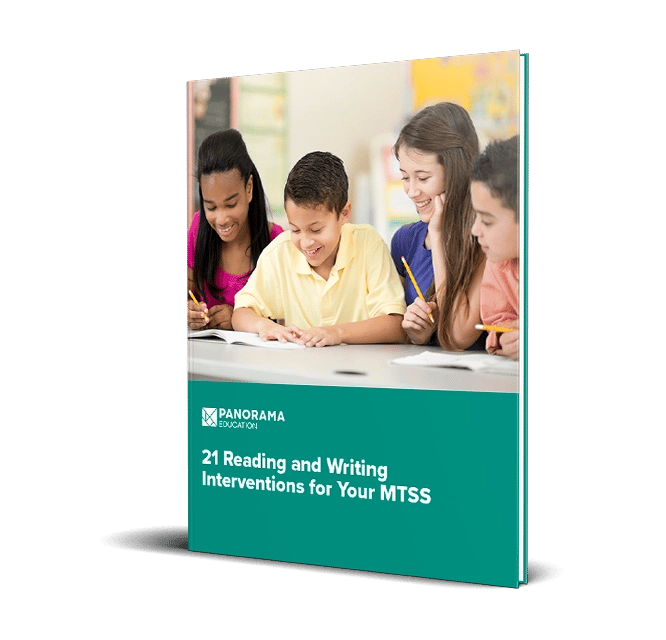Despite its importance as a cornerstone of academic success, writing instruction often gets the short end of the stick in the classroom. An essential form of communication across all fields, writing is often relegated to the English Language Arts classroom—where it is second fiddle to reading instruction. Educators prioritize teaching reading due, in part, to its role in standardized testing, and effective writing instruction can fall to the wayside.
Busy teachers don’t have the time to find and vet effective writing resources. That’s why we put together this list of five research-based writing strategies to give students explicit instruction and practice in writing.
Below you’ll find implementation instructions for writing activities to support students’ writing skills at every grade level, from elementary school through high school.
|
Key Takeaways:
|
Access 21 reading and writing interventions in our free toolkit
1. Paragraph Burger
The Paragraph Burger is a strategy to teach writing to students at all levels, across genres. This visual graphic organizer supports students in the planning process of writing.
-
Author: Panorama Education
-
MTSS Tier: Tier 1
-
Developmental Stages: Lower Elementary, Upper Elementary, Middle School
-
Goal: Assist students with organizing paragraph structure for a given writing task
Action:
Preparation:
- Create or print paragraph burger worksheets for individual student use.
-
Prepare a completed and annotated burger template to display in the classroom for modeling and student reference.
Instructions:
-
Explain to students that well-written paragraphs follow a particular structure. Tell them that they will be using the Paragraph Burger graphic organizer to plan their writing.
-
Distribute the burger template and review the parts of a paragraph as students follow along on the template:
The top bun represents the introduction or topic sentence of the paragraph. This sentence should “preview” the rest of the paragraph for the reader.
The fillings (middle) of the burger represent supporting details. These should “prove” what was stated in the first sentence.
The bottom bun represents the concluding sentence of the paragraph. This sentence should restate the introduction in a new, connected way.
-
Work as a class to create a simple model paragraph based on general knowledge (for example, how to tie your shoe or brush your teeth). Highlight the topic sentence, supporting details, and conclusion as each is created.
-
Instruct students to try the strategy on their own. Then, ask volunteers to share their finished Paragraph Burgers with the class, or have students share within a small group.
Why this works
The Paragraph Burger strategy is an effective planning tool to support student writing and highlight the components of a structured and well-written paragraph.
In addition, it provides a visual model that can help developing writers across levels of writing proficiency organize and relate information concretely.
2. Four-Square
The four-square method is a strategy used to help students at all writing levels plan and organize their writing within a simple graphic organizer.
- Author: Panorama Education
- MTSS Tier: Tier 1
- Developmental Stages: Lower Elementary, Upper Elementary, Middle School, High School
- Goal: Provide students with visual and scaffolded pre-writing, or planning, support
Action:
Preparation:
- Identify a writing prompt to use with this strategy.
- Provide blank sheets of paper to students if they will be making their own four-square organizer. Alternatively, print and distribute a premade four-square template to students.
- Prepare an example four-square organizer to share with students as a model.
- Inform students of the writing prompt. Engage in a class discussion regarding the topic to activate prior knowledge.
- Introduce the Four-Square graphic organizer, showing students the model you prepared. Explain that they will use a Four-Square organizer to plan and organize their writing.
- If students will be making their own graphic organizers, instruct them to fold a sheet of paper in half twice, once horizontally and once vertically. Then have them unfold the paper and draw a box in the center that overlaps all four squares.
- Tell students to think about how they will answer the writing prompt in one paragraph. Then have them write the topic sentence of the paragraph in the center box.
- Instruct students to write supporting details in the outer squares.
- Discuss how students might use the completed four-square organizer to complete the writing assignment as a class. If time allows, have students take these steps.
Why this works
The four-square graphic organizer is a visual and kinesthetic approach to pre-writing. Students can perform various planning tasks, from identifying details to conceptualizing their final product. The organizer can be used as a scaffold, with the writing task broken down into more digestible pieces.
3. Mentor Texts
By observing, rereading, and closely analyzing published writing, students see examples and learn the strategies of good writing that they can integrate into their own compositions.
- Author: Digital Promise
- MTSS Tier: Tier 1
- Developmental Stages: Middle School, High School
- Goal: Through discussions and rereads of mentor texts, students develop their own voice and confidence by seeing how the authors create their own voice.
Action:
Preparation:
- Identify a text that exhibits the aspects of writing you want students to adopt in their own writing, such as text structure, vocabulary, or syntax.
- Prepare copies of the text for each student to annotate in class.
Instructions:
- Read the text out loud or have the students read to themselves in class.
- Introduce students to the specific writing concepts they’ll be identifying in the text.
- Have students work in pairs or small groups to discuss and annotate the text. For example, if you are using the text to teach students to develop a topic, they can discuss and annotate the text for significant and relevant facts, concrete details, and relevant quotes.
- Tip: Offer students multiple opportunities to encounter the text to deepen their understanding.
Example: Use This Strategy In Your Classroom
Watch how these 11th grade teachers use a mentor text to develop students' abilities to select the most significant details in a text. As students reread their text to find evidence and quotations, they identify concrete techniques that they can try in their own writing, developing their disciplinary literacy skills.
Why this works
Learning science research provides insights into how best to support and engage our full diversity of learners. The Learner Variability Project (LVP) team at Digital Promise works at the intersection of researchers, educators, and edtech developers to design and develop a more rich and equitable education for each learner.
|
Have you heard the news? Panorama has partnered with Digital Promise, a global nonprofit focused on increasing access to research-backed resources for educators. Through Panorama’s Playbook, Digital Promise is offering a set of ELA interventions, math interventions, and adult well-being strategies from their Learner Variability Navigator project. |
4. Sentence Starters
Sentence starters are a tool designed to support students in creating complete, assignment-appropriate (spoken and written) sentences. The strategy can be used to scaffold student learning and offer specific support to English language learners and emerging writers.
- Author: Panorama Education
- MTSS Tier: Tier 1, Tier 2
- Developmental Stages: Lower Elementary, Upper Elementary
- Goal: Give students a scaffold for relaying main ideas and concepts using complete sentences
Action:
Preparation:
- Decide on the prompt or topic students will be required to write about. Then, create related Sentence Starters and provide them to each student.
- Sentence Starters can be scaffolded to guide students in how they sequence and form the ideas within their writing. For example, the first starter may target summarizing (e.g., This idea is supported by details such as __, __, and __). The second starter can target higher depth of knowledge, such as inferring (e.g., The author is implying ___ by ___).
Instructions:
- Inform students that sentence starters are a way for writers to guide their thinking and help them get their ideas on paper.
- Display or distribute the sample writing prompt. Review it with students. Then share two or three sample Sentence Starters. Finally, briefly model how one might complete the Sentence Starters using prior knowledge or new information.
- Display or distribute the Sentence Starters students will use.
- Direct students to refer to the Sentence Starters throughout their drafts to accurately share their ideas in writing.
- Optional: Have students read completed Sentence Starters aloud with a partner.
Why this works
Beginning writers often have difficulty verbalizing or writing down their thoughts and ideas. Using sentence starters provides the needed support to translate their ideas on paper accurately.
Additionally, when students complete and read the starters aloud, they share and hear various sentence structures and vocabulary and engage in academic conversations. Starters support students in being specific with their ideas, provide a starting point for writing, and decrease anxiety about the writing process.
5. Paraphrasing
Successful paraphrasing involves identifying key ideas and supporting details in a text and rephrasing them using simpler language. A paraphrase is often the same length as or longer than the original text.
The ability to paraphrase a text demonstrates that a student has read critically and proficiently.
- Author: Panorama Education
- MTSS Tier: Tier 1, Tier 2
- Developmental Stages: Upper Elementary, Middle School, High School
- Goal: Students can accurately recount key ideas and details in a text after reading it, using original language and phrasing. This strategy aims to help students recall the text and strengthen their analytical reading skills. In a classroom, it helps teachers monitor students’ comprehension of texts.
Action:
Preparation:
- Identify a text that you can use to model paraphrasing.
- Consider a text that can be used in multiple settings, such as within a small group or for independent student work.
Instructions:
- Explain to students that paraphrasing means stating a text’s main ideas and details in your own words. Share that paraphrasing is an important strategy to check your comprehension of a text during and after reading.
- Model the strategy: Project a short text and read it aloud to the class. Think aloud about your process for identifying both key ideas and details, allowing students to track your thought process. Use digital markup strategies for additional scaffolded support (circle main ideas, underline details, etc.).
- Next, model how to transform this initial paraphrase into a short paragraph. Pause to define plagiarism (to use another person’s ideas or words as your own without properly crediting them) and explain the importance of avoiding it, especially through unattributed direct quotations.
- Share tips for making it easier to put text in your own words, including rereading, looking up unfamiliar words and identifying synonyms, taking notes as bullet points instead of complete sentences, combining and dividing sentences, and changing the order of ideas while maintaining a logical sequence.
- Guided practice: Guide students in performing the strategy in small groups. Project or provide a copy of another short text. Have a volunteer in each group read aloud the text. Then direct students to reread the text and work together to identify key ideas and details, using markup strategies as needed. Each group should then write a short paragraph, paraphrasing the text.
- Call on groups to share their paragraphs with the rest of the class. Encourage students to identify any problems they encountered while trying to put the text in their own words and troubleshoot as a class, using the tips you introduced earlier.
- Independent practice: Have students perform the same activity independently with a new text. Before students write their paraphrase, have them use any notes they have to explain the text to someone else. If the partner has trouble understanding the paraphrase, encourage the student to reread further and annotate the text.
Why this works
Educational research indicates that when students successfully understand and apply the strategy of paraphrasing, a significant increase in reading comprehension occurs. In addition, the ability to recount key ideas and details in a reader’s own words can offer the complementary advantages of increased comprehension and reading confidence.
|
Frequently Asked Questions: 1. How can we ensure that writing instruction is aligned with curriculum standards and goals? To ensure alignment with curriculum standards and goals, school and district leaders should regularly review and analyze curriculum documents, standards, and assessments related to writing. Provide professional development opportunities for teachers to deepen their understanding of writing standards and instructional best practices. Collaborate with teachers to develop writing benchmarks and rubrics that align with curriculum goals. 2. What resources and professional development opportunities are available to support teachers in effective writing instruction? School and district leaders can provide teachers with access to research-based writing resources, such as writing toolkits, mentor texts, and online writing platforms. Offer professional development workshops, seminars, and coaching sessions focused on writing instruction, assessment, and MTSS intervention strategies. Encourage collaboration among teachers through PLCs (Professional Learning Communities) to share best practices and support each other's professional growth. 3. How can we foster a culture of writing across all subjects and grade levels? To foster a culture of writing, school and district leaders can promote the integration of writing across all subjects and grade levels. Encourage interdisciplinary projects and assignments that incorporate writing as a means of learning and demonstrating understanding. Showcase student writing through publications, exhibitions, and digital platforms to celebrate their achievements and inspire others. 4. What data should we collect and analyze to monitor students' progress in writing? School and district leaders should collect and analyze both formative and summative assessment data to monitor students' progress in writing. This may include writing samples, rubric scores, standardized test results, and writing proficiency benchmarks. Use data analysis tools and platforms to track trends over time, identify areas for improvement, and inform instructional decision-making. |
Supporting the Whole Student
Learning recovery is top of mind for district administrators and MTSS leaders everywhere. Now more than ever, students need holistic support and research-based practices that improve their learning.
Ensuring educators in your district have access to high-quality strategies for teaching writing will enable students to reach their full academic potential.







